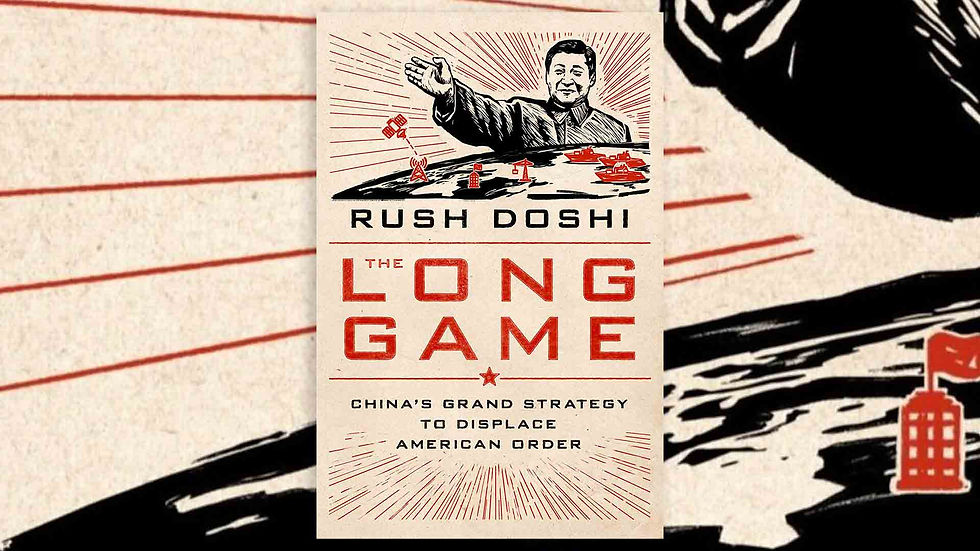China’s Long Game: How Beijing Plans to Displace the U.S. as Global Leader
- vickygunawan
- Mar 16
- 4 min read

For years, the U.S. has been the world’s leading superpower. But China is working on a long-term plan to take that position.
In The Long Game: China’s Grand Strategy to Displace American Order, Rush Doshi reveals that China’s rise isn’t random—it follows a step-by-step strategy to replace U.S. global leadership.
So how is China doing this? Let’s break it down in simple terms.
China’s Step-by-Step Plan to Overtake the U.S.
Doshi explains that China’s plan unfolded in three stages, each with a clear goal.

Phase 1: “Hiding and Biding” (1989–2008)
▶ China’s Goal: Grow strong without making enemies.
After the Tiananmen Square protests (1989), China feared the U.S. might try to stop its rise.
Deng Xiaoping’s strategy: “Hide your strength, bide your time.”
China focused on economic growth, joining the World Trade Organization (WTO) in 2001 to boost its economy.
It avoided military aggression to keep the U.S. from seeing it as a threat.
💡 Takeaway: China played it safe while secretly getting stronger.
Phase 2: “Active Displacement” (2008–2016)
▶ China’s Goal: Challenge U.S. dominance, especially in Asia.
The 2008 Global Financial Crisis made China believe the U.S. was weakening.
Xi Jinping (2012) abandoned the "low profile" approach and became more aggressive:
Built military bases in the South China Sea.
Launched the Belt and Road Initiative (BRI) to expand China’s economic power worldwide.
Created the AIIB (Asian Infrastructure Investment Bank) as an alternative to the U.S.-led World Bank.
Invested in tech dominance (5G, AI, semiconductors) to reduce reliance on U.S. technology.
💡 Takeaway: China stopped hiding and started actively challenging the U.S. in Asia.
Phase 3: “Global Leadership” (2016–Present)
▶ China’s Goal: Replace the U.S. as the world’s top superpower.
The 2016 U.S. election and Trump’s “America First” policies created a global leadership gap.
Xi Jinping stepped in to fill that gap, openly pushing for China to lead the world.
China’s new strategies include:
Building more military bases abroad (e.g., Africa, Pacific region).
Expanding the yuan’s use in global trade to compete with the U.S. dollar.
Gaining influence in the UN, WHO, and other international organizations.
Spreading its own model of state-controlled capitalism as an alternative to U.S.-style democracy.
💡 Takeaway: China is no longer just competing—it is actively working to replace the U.S. as the global leader.
Where China is Challenging the U.S.
China isn’t just focusing on one area—it’s challenging the U.S. on three major fronts.
1. Military Power: Pushing the U.S. Out of Asia
▶ China’s Goal: Reduce U.S. military presence in Asia and expand its own global reach.
Building military bases in the South China Sea to claim territory.
Expanding its navy—it now has more ships than the U.S. Navy.
Investing in cyber warfare and space dominance to gain an edge in future conflicts.
💡 Lesson: China wants to control Asia first, then expand globally.
2. Economic Power: Making the World Depend on China
▶ China’s Goal: Build an economic system where China—not the U.S.—is the center.
Belt and Road Initiative (BRI) – China is funding roads, railways, and ports worldwide to expand its economic influence.
Trade agreements that exclude the U.S. (e.g., RCEP, the world’s largest trade deal).
Investing in key industries (5G, AI, semiconductors) to become self-sufficient.
💡 Lesson: China is making countries economically dependent on it instead of the U.S.
3. Political & Ideological Influence: Rewriting the Global Order
▶ China’s Goal: Change the rules of international politics to favor China.
Gaining control over global organizations (e.g., increasing influence in the UN, WHO, WTO).
Expanding Chinese media influence (e.g., state-controlled news channels in Africa, Latin America).
Selling surveillance tech (e.g., Huawei, TikTok) to help authoritarian governments control their populations.
💡 Lesson: China isn’t just challenging the U.S. with money and military—it’s reshaping global politics itself.
Key Takeaways from The Long Game
This book is a must-read if you want to understand China’s long-term strategy. Here are the biggest lessons:
1. China’s Strategy is Long-Term and Well-Planned
The U.S. often reacts to world events short-term.
China thinks in decades, carefully planning each step.
2. The U.S. Underestimated China’s Ambitions
The West thought integrating China into the global economy would make it more democratic.
Instead, China used economic growth to strengthen its authoritarian rule.
3. Economic Power Leads to Military and Political Power
Unlike the Soviet Union (which relied on military strength alone), China focused on building a strong economy first.
Now, it’s using that wealth to expand its military and global influence.
4. The U.S. Needs a Clear Strategy to Compete
The window to contain China is closing.
If the U.S. doesn’t counter China’s economic, military, and political expansion, it risks losing its position as the world’s leader.
Final Thought: What’s Next?
Rush Doshi’s The Long Game proves that China’s rise is not accidental—it’s part of a long-term strategy.
The big question is: Can the U.S. catch up, or is it already too late?
🚀 What do you think? Can the U.S. counter China’s grand strategy? Let me know in the comments!
📌 BONUS: Visual Insights – China vs. U.S. Global Power Shift
Dive deeper with exclusive charts showcasing China’s rise and its strategic competition with the U.S.:
✅ Military Spending (2023-2025) – Who’s leading the defense race?
✅ Belt & Road Initiative Investments – Mapping China’s global influence.
✅ Export Growth (2000-2025) – How China became the world’s top exporter.
✅ AI & Semiconductor Market Trends – The tech battleground of the future.
📊 Scroll down to explore the data! 🚀
Sources: SIPRI, U.S. DoD, GFDC, Statista, WTO, UN Comtrade, Stanford AI Index, McKinsey, , SEMI, U.S. Dept of Commerce, SCMP.
@beetvemiona

















Comments